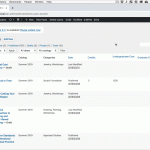Hi there,
This question may be beyond what Toolset Support can provide, but perhaps the wizards are feeling generous today.
The goal: on the "All items" list of a custom post type in the WordPress dashboard, add an additional pull-down menu by which to filter the list of posts. For example, I'm building a course catalog for the Continuing Education department at a college of art and design. New catalogs launch every season. I'd like to filter the list of all courses by season so I can focus on just spring and ignore summer. Does that make sense?
Here's the code I came up with (based on reading https://wordpress.stackexchange.com/questions/45436/add-filter-menu-to-admin-list-of-posts-of-custom-type-to-filter-posts-by-custo):
// add the select menu to choose the catalog season
function pce_restrict_filter_admin_posts ( ) {
$type = 'section' ;
if ( isset ( $_GET['post_type'] ) ) {
$type = $_GET['post_type'] ;
}
if ( 'section' == $type ){
$catalogs = get_posts ( array ('numberposts'=> -1, 'post_type' => 'catalog' ) ) ;
$values = array ( ) ;
foreach ( $catalogs as $catalog ) {
$values[$catalog->post_title] = $catalog->ID ;
}
?>
<select name="catalog">
<option value="">All catalogs</option>
<?php
$current_value = isset ( $_GET['catalog'] ) ? $_GET['catalog'] : '' ;
foreach ( $values as $label => $value ) {
printf
(
'<option value="%1$s"%2$s>%3$s</option>',
$value,
$value == $current_value ? ' selected="selected"' : '',
$label
);
}
?>
</select>
<?php
}
}
add_action ( 'restrict_manage_posts', 'pce_restrict_filter_admin_posts' ) ;
// modify wp_query before it's executed
function pce_filter_posts ( $query ){
global $pagenow;
$type = 'section';
if ( isset ( $_GET['post_type'] ) ) {
$type = $_GET['post_type'];
}
if ( 'section' == $type && is_admin ( ) && $pagenow == 'edit.php' && isset ( $_GET['catalog'] ) && $_GET['catalog'] != '' && $query->is_main_query ( ) ) {
$section_ids = toolset_get_related_posts ( $_GET['catalog'], 'catalog-to-section-relationship', array ( 'query_by_role' => 'parent', 'limit' => 999, 'return' => 'post_id', 'role_to_return' => 'child' ) ) ;
$query->query_vars['post__in'] = $section_ids ;
unset ( $query->query_vars['name'] ) ;
}
}
add_filter ( 'parse_query', 'pce_filter_posts' ) ;
The above code actually works. Here's my issue: after I press the "Filter" button, the listing of posts on the screen that loads next no longer displays the filter menu. It disappears. Please see the attached animated GIF. Do you know why the menu is disappearing?
Saul
